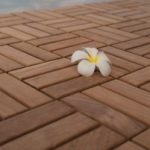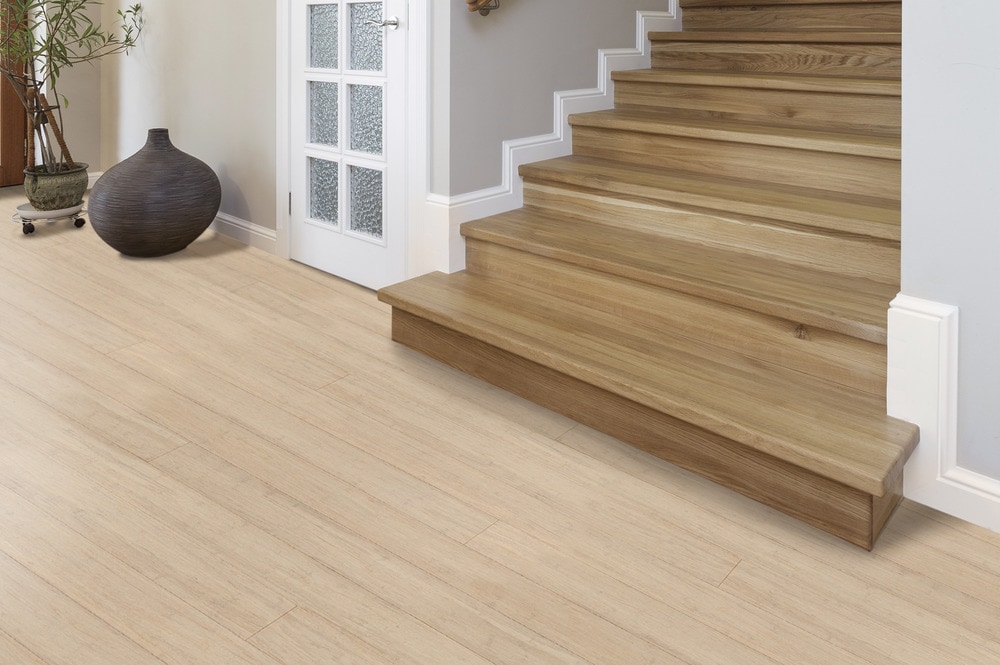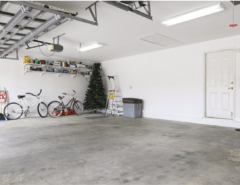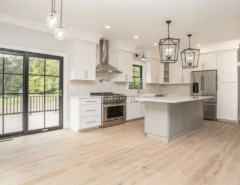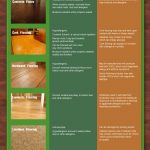Yanchi Varuna Waterproof Engineered Bamboo Collection/ SKU: 15273473
Is your flooring needing a revamp? Replacing old flooring with new bamboo is an excellent way to brighten your space with an eco-friendly material. Also unlike most types of wood, bamboo flooring is in plentiful supply and simple to replenish. However, if you’ve never purchased or installed this material before, you may have a few questions. From maintenance tips to average cost, learn what questions to ask when shopping for bamboo flooring.
Is This Strand-Woven Bamboo or a Grain Pattern?
When you’re browsing for bamboo, one of the first items you’ll notice is that it comes in a variety of patterns and looks. Manufacturers use one of three main techniques to make this type of flooring, which you’ll begin to easily recognize the more you shop.
- Strand Woven: This form is the most even and natural-looking method. To create strand-woven bamboo flooring, manufacturers shred the bamboo stalks and recombine them before laminating. You’ll see the fewest lines and distinctive features on strand-woven flooring.
- Horizontal Grain: This technique requires manufacturers to place bamboo strips atop one another. Horizontal grain bamboo flooring typically reveals the most joint lines along with some natural features.
- Vertical Grain: To create vertical grain bamboo flooring, manufacturers place the strips on their sides and use pressure to create panels. This type of flooring usually has the most joint lines but relatively few natural features.
When it comes to grain pattern, you won’t find a bad choice. All three of these looks can work in a number of settings, so choose the one that appeals to you and looks best in your space.
How Much Variation Is in the Color and Grain Pattern?
Yanchi Varuna Waterproof Engineered Bamboo Collection / SKU: 15273480
Whether you’re shopping for strand-woven flooring in a natural hue or vertical grain flooring in a gray tone, you can find bamboo flooring that meets your needs. No matter which look you choose, however, part of the appeal of bamboo flooring is that it’s a natural product made from plants that grow across the globe. No two panels are identical, and you can’t expect every panel to look the same, even when you order from the same lot, manufacturer, and supplier.
Before ordering your bamboo flooring, always ask how much variation to expect in terms of color and grain pattern. Experienced suppliers can communicate the level of variation from panel to panel, and you can use that information to assess whether the flooring will work in your space.
How Does Bamboo Flooring Stand Up to Scratching?
Bamboo is known for being a hard, durable surface that lasts a long time with appropriate care. While an official grading system doesn’t exist for bamboo flooring, you can typically judge how strong a style is based on its natural color and its production method. For example, a darker natural tone indicates an older and less durable material. In addition, strand-woven bamboo flooring tends to be the strongest.
As strong as bamboo is, however, keep in mind that no flooring type is completely immune to scratches, gouges, or dents. This point is especially true if you’re planning to install bamboo flooring in a high-traffic area, such as the entryway of your home, the living room, or the kitchen. If you want to see how well bamboo stands up to your expected level of use, take the time to order a sample and test how well it stands up to impacts from high heels, gouges from furniture, and scratches from pet claws.
What’s the Best Way to Keep Bamboo Flooring in Good Condition?
Purchasing the strongest and most durable material available makes maintaining bamboo flooring easy. If you’re concerned about durability, be sure to choose a material that comes with several layers of ultraviolet (UV) coating. Flooring with at least six coats of aluminum oxide treatments tends to be the most durable and resistant to damage.
After installation, be sure to care for your bamboo flooring regularly. Since sand, dirt, and gritty substances can damage bamboo, take care to sweep the floor frequently. Keep bamboo flooring dry at all times and moderate humidity to prevent water damage. Consider using rugs to limit impacts from hard-soled shoes or declare your bamboo flooring to be a shoe-free zone. Place felt furniture pads under tables, chairs, and sofas to protect your new floors, too.
How Much Will This Cost?
Since bamboo flooring is available in many colors, grains, and styles, you’ll find a range of prices. Expect to pay anywhere between $2 and $10 per square foot for bamboo flooring. For a typical bedroom, bamboo flooring costs around $600, and for an average living room, you’ll pay closer to $1,650.
Remember that this cost covers the flooring panels only. If you need to update the subfloor or purchase tools, for example, you’ll pay a bit more. If you opt to hire a local contractor to install your new flooring, you can expect to pay an installation fee similar to what you’d pay for standard hardwood flooring.
Is Bamboo Flooring a Good Choice for My Room?
 Yanchi Stained Click-Lock Solid Strand Woven Bamboo Flooring / SKU: 15273473
Yanchi Stained Click-Lock Solid Strand Woven Bamboo Flooring / SKU: 15273473
While bamboo flooring looks great in almost any room, it isn’t always a good choice for every space. Since bamboo doesn’t hold up well to moisture or humidity, this flooring type isn’t ideal for bathrooms. After all, many bathrooms are high-humidity zones where water frequently pools on the floor.
Kitchens can also be challenging environments for bamboo flooring due to the heavy traffic, frequent spills, and ample moisture. If you do opt to install bamboo flooring in your kitchen, be sure to choose a treated strand-woven material that can withstand impacts, spills, and water. Take care to wipe up food and liquids quickly, and consider placing rugs in areas where spills frequently fall.
You’ll also want to think twice before installing bamboo flooring in a basement. Since these below-grade spaces tend to be more humid than rooms on the main floor or upper floors, the excess moisture can damage bamboo and cause it to be less resilient to impacts. If you do want to install bamboo in your basement, test the concrete slab underneath to ensure that the moisture levels are low, and choose a flooring type that includes a long-term warranty.
Ready to find your ideal flooring? Start shopping for bamboo flooring and choose the best quality, color, and look for your home.
Resources:
https://www.builddirect.com/Bamboo-Flooring
https://www.builddirect.com/learning-center/flooring/bamboo-flooring-overview/





